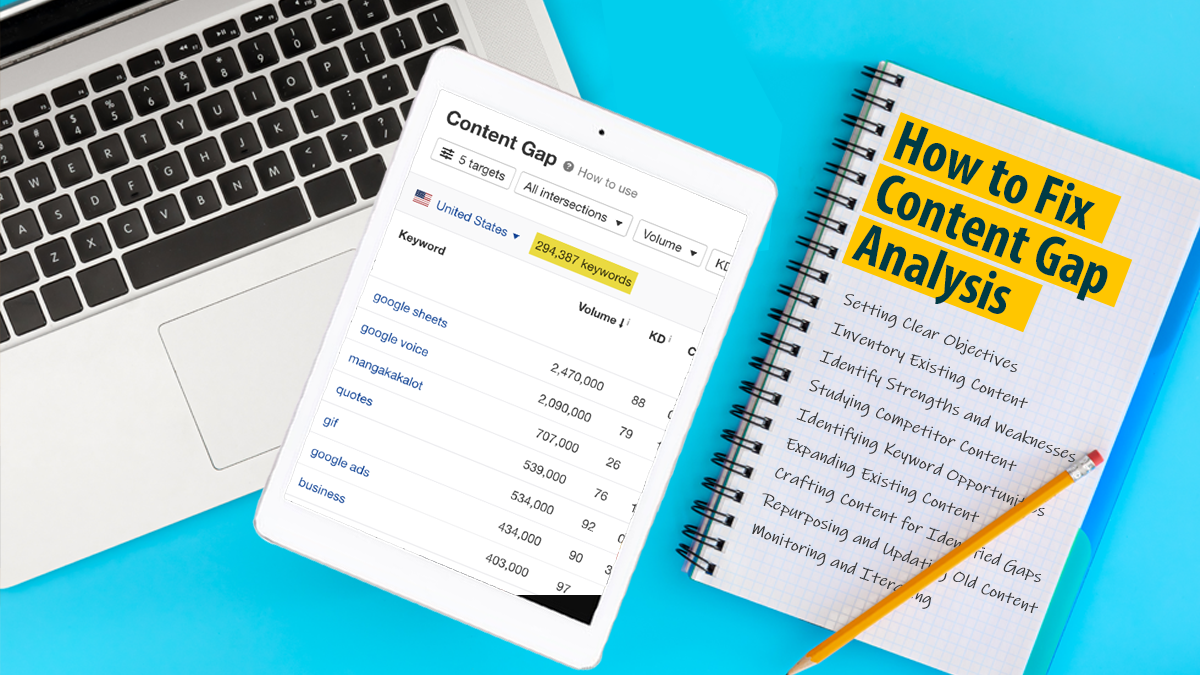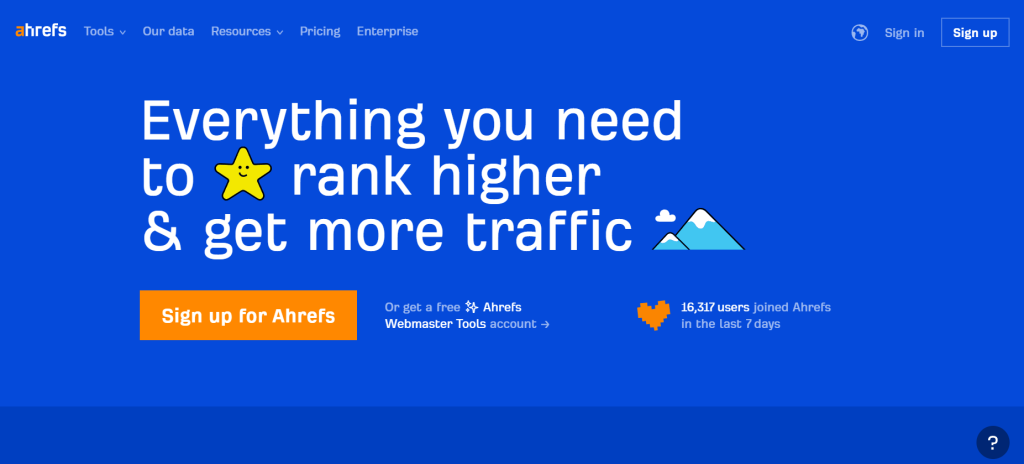A successful online presence hinges on providing valuable content that resonates with your target audience. Content is the bridge that links businesses to their potential customers. Comprehensive content goes beyond mere basic information, delving into detailed insights, answers, and solutions.
True relevance in content lies in meeting user expectations and addressing their questions or concerns. Engaging content not only educates and captures interest but also instills trust, laying the foundation for lasting customer relationships.
Content gap analysis is the process of pinpointing discrepancies between your current content and the needs of your audience. This involves examining your existing content, comparing it with competitors, and gauging audience demands to ascertain areas needing enhancement.
By addressing these content voids, you can curate specific content that caters to these needs, leading to increased organic traffic, improved search engine positioning, and meeting your audience’s distinct requirements. The role of content gap analysis in adapting to market shifts and staying competitive is invaluable, a topic we will delve deeper into in this article.
What Is Content Gap Analysis?
Definition and Its Significance in SEO
Content gap analysis is a systematic approach in SEO to evaluate website content, juxtapose it with competitors’, and gauge user preferences. This method reveals shortcomings in content or areas where user needs aren’t being met, paving the way for curating tailored content that fills these informational voids.
Its significance in SEO is paramount. By refining content relevance, websites can draw more organic traffic, elevate their search rankings, and effectively address specific user queries and requirements.
Hiring a full-time content writer ensures consistent and high-quality content production, effectively filling any content gaps on your website. This dedicated resource can focus on targeted keyword research, SEO optimization, and creating a variety of content types, thereby enhancing your online presence and driving organic traffic.
Overview of How It Affects Search Engine Ranking and Website Relevance
The meticulous act of content gap analysis directly influences a website’s ranking in search engine results and its relevance to users. By addressing content deficiencies and incorporating vital additions, websites can enhance their utility to users. Search engines, in turn, reward comprehensive and pertinent content with higher rankings.
Furthermore, when users find accurate solutions to their queries, they tend to engage more with the content, remain on the site longer, and are more likely to take desired actions. This heightened user interaction boosts the website’s search engine visibility and cements its relevance for both users and search engines.
The Importance of Addressing Content Gaps
Enhancing Website Authority and Trustworthiness
In the digital landscape, bolstering a website’s credibility and trustworthiness is paramount. Regularly identifying and addressing content gaps and delivering accurate and insightful content, are pivotal in this endeavor. When websites proactively fill these gaps with valuable, well-researched information, they position themselves as trusted information hubs.
This not only fosters user trust but also bolsters the website’s reputation within its niche. Establishing trust and emerging as an authoritative figure are instrumental for favorable search engine rankings. Moreover, these attributes encourage repeat visits, fostering brand loyalty. Ultimately, this paves the way for sustained success amidst fierce online competition.
Improving User Experience by Offering Comprehensive Information
User experience is the linchpin of a website’s success. Content gap analysis plays a significant role by ensuring that users consistently find relevant and beneficial information tailored to their needs. When a site offers a comprehensive repository of insights, users are inclined to engage more deeply, linger longer, and return for further queries.
Enhancing the user experience doesn’t merely reduce bounce rates; it amplifies overall user satisfaction. A positive user experience fosters trust, loyalty to the brand, and sparks word-of-mouth recommendations. All of which are integral for long-term website success and audience growth.
Boosting Organic Search Visibility and Traffic
The cornerstone of SEO is augmenting online visibility and driving website traffic. A thorough content gap analysis is indispensable to realizing this goal. By discerning the shortcomings in your content strategy and crafting precise, relevant content to bridge these gaps, you elevate the website’s overall value to users and search queries.
Search engines reward pertinent websites with higher placements in search results, enhancing their discoverability. As a result, more users organically gravitate towards your website, drawn by its relevant and useful content. This approach ensures a consistent and growing stream of visitors who discover and engage with your website via search engines.
Key Steps in Conducting Content Gap Analysis
Setting Clear Objectives
Beginning with well-defined goals is crucial for devising an effective content creation and dissemination strategy. This entails establishing measurable, time-bound objectives aligned with your content aims. These benchmarks facilitate content alignment with broader business or marketing targets.
Simple objectives might encompass increasing website traffic, boosting product or service sales, or enhancing brand awareness. With unambiguous targets, you can gauge content performance and refine your approach accordingly.
Analyzing Your Content
- Inventory Existing Content
Commence by cataloging all your existing content, be it blog entries, articles, videos, or other resources. This inventory assists in pinpointing information voids, redundant content, and potential enhancements.
A comprehensive understanding of your content repository aids in making informed decisions about modifications, augmentations, or removals, ensuring alignment with your overarching content strategy and audience expectations. A well-organized inventory contributes to streamlined website navigation, enhancing user experience and making the site more SEO-friendly.
- Identify Strengths and Weaknesses
To tailor an effective content strategy, assess the efficacy of your current content. This involves evaluating aspects such as relevance, engagement, and performance. Recognizing what resonates allows for replicating successful content features.
Conversely, spotlighting areas of improvement empowers you to bridge content gaps, enhance underperforming content, and fine-tune your strategy. This introspection provides insights into audience preferences, areas necessitating refinement, and ensures alignment with primary objectives. Ultimately, this paves the way for a more robust and captivating content repository.
Studying Competitor Content
- Using Tools Like Ahrefs or SEMrush to Find Topics Your Competitors Rank for, But You Don’t
Leverage tools like Ahrefs and SEMrush to discern your competitors’ strategies. These platforms provide insights into the topics and keywords propelling your competitors’ search rankings—areas your content might be overlooking.
By addressing these gaps, you can strategically curate content on these themes, thereby capturing the audience segment your competitors cater to. This not only amplifies your content reach but also bolsters your niche positioning, positively impacting your search engine ranking and the holistic content strategy.
- Pinpointing Content Formats That Are Missing on Your Site
Recognizing absent content formats on your website can diversify and enrich your content strategy. By analyzing competitors and industry forerunners, you can discern preferred content types that are currently absent from your site, such as videos, infographics, podcasts, or interactive tools.
Incorporating these absent formats can cater to varied user inclinations, heighten engagement, and ensure your content strategy remains contemporary. Additionally, it bolsters your brand’s distinctiveness and provides users with a multifaceted and captivating experience.
Identifying Keyword Opportunities
Isolating yet-to-be-explored keywords pertinent to your niche is a strategic move to elevate your content. Keyword research tools paired with competitor scrutiny can unveil untapped keyword prospects resonating with your industry or your audience’s predilections. Targeting these overlooked keywords can lead to the development of fresh content or the optimization of existing pages for better rankings.
This not only broadens your content’s reach but also draws in a diverse spectrum of potential users actively seeking information in your domain. Staying agile and targeting these keywords ensures competitiveness and draws valuable web traffic in the ever-evolving SEO landscape.
Implementing Findings From Gap Analysis
Content Creation and Expansion
- Crafting Content for Identified Gaps
Producing content tailored to pinpoint gaps is a judicious tactic to fortify your brand’s content stance. Recognizing areas where your audience encounters information scarcity or seeks solutions paves the way for specialized content catering to those needs.
This proactive approach not only positions you as a domain authority but also magnetizes those in quest of insights. It offers a platform to provide invaluable perspectives, address unresolved queries, and cater to unmet requirements, thus amplifying brand allegiance and enhancing user engagement.
- Expanding Existing Content to Be More Comprehensive
Refining and expanding pre-existing content involves revisiting and enhancing it. By detecting sections of your content that lack depth or comprehensiveness, you can fortify them with additional data, illustrative examples, and beneficial references. Such rejuvenation not only amplifies the quality of your existing content but also enhances its search engine positioning.
Content rich in substance and clarity often secures premier spots in search results, retaining user attention for extended durations. It’s a strategic avenue to optimize existing resources while satiating your audience’s information appetite in a cost-efficient manner.
Repurposing and Updating Old Content
- Bringing Outdated Content Up-to-Date
Keeping your website’s content fresh and accurate is crucial for maintaining its relevance and trustworthiness. As facts and trends evolve, content can quickly become obsolete. Regularly reviewing old content to update statistics, facts, and insights ensures accuracy. Integrating the latest data, contemporary examples, and new insights maintains the content’s relevance.
Such updates not only preserve the content’s value for readers but also signal to search engines that the site houses current information, potentially boosting search rankings. By rejuvenating outdated content, you prolong its lifespan, maintain readers’ trust, and continue drawing organic traffic with renewed, trustworthy information.
- Repurposing Content Into Different Formats
Repurposing entails adapting existing content into varied formats, such as videos, infographics, podcasts, or eBooks, catering to diverse audience preferences.
For example, transforming a written post into a video or infographic can captivate individuals who gravitate towards visual content or favor condensed overviews. By leveraging content across different media, you expand its reach, amplify its lifespan, and cater to a broader audience segment. This approach maximizes the utility of pre-existing content and disseminates your message more widely.
Example: Turning a Blog Post Into a Video
Converting a blog article into a video involves several essential steps:
- Selection: Start by picking an article rich in visual potential. Transform its content into a script suitable for a dynamic video narration.
- Visuals: Curate images, animations, or video footage that complement the story you intend to narrate.
- Audio: Record a crisp and engaging audio narration that mimics a natural dialogue, ensuring it’s suitable for video consumption.
- Editing: Post-recording, employ video editing software to seamlessly synchronize the audio with visuals. Enhance the video’s appeal by integrating background music, sound effects, and smooth transitions, elevating its professional quality.
- Optimization: Before distributing the video, ensure it’s SEO-friendly. Incorporate relevant keywords in its title, description, and tags to boost visibility on search platforms.
To illustrate, consider a travel-centric website featuring a popular article titled “10 Best Places to Visit in Europe.”
Blog Post: The article provides an in-depth exploration of each destination, coupled with valuable travel tips and captivating images. Recognizing that some audiences might lean towards visual content with concise information rather than extensive prose, the blog owner considers repurposing the post.
Changing It Into a Video:
Scripting: The blogger extracts key points and highlights from each destination, condensing the travel advice for brevity and clarity.
Visual Elements: The video showcases stunning images and clips of European landmarks, intertwined with footage of the blogger’s personal adventures.
Narration: Delivered in a lively and dynamic tone, the narration transports listeners on an immersive virtual journey.
Editing: Leveraging video editing tools, the blogger ensures seamless synchronization between audio and visuals, crafting a pleasurable viewing experience.
Music and Effects: Subtle background music enriches the viewing experience, complementing the narrative without overshadowing it.
Impact of the Transformation:
Increased Reach: Upon sharing the video on YouTube, it draws not only new viewers with a penchant for travel visuals but also appeals to the blog’s existing audience who appreciate video content.
Enhanced Engagement: With its compelling visuals and engaging narration, the video maintains viewers’ interest, potentially garnering more interactions than its textual counterpart.
SEO Boost: Optimizing the video with pertinent keywords boosts its visibility on search platforms, driving organic traffic to both the original article and the video without additional advertising costs.
Brand Authority: Diversifying content offerings solidifies the blog owner’s stature as a travel aficionado, cementing their position as a go-to source for travel enthusiasts.
Monitoring and Iterating
- Using Analytics to Monitor the Performance of Updated or New Content
Analytics play a pivotal role in assessing the impact of revised or new content. Tools like Google Analytics offer invaluable insights into website performance metrics such as visitor count, bounce rate, click-through rates, and conversion metrics.
These metrics provide a clear picture of user engagement with your content, indicating its efficacy. For instance, discerning which keywords drive traffic can inform content creation, while areas of high bounce rates might pinpoint content that needs enhancement. Leveraging analytics empowers data-driven decision-making, refining your content strategy to more effectively cater to your audience’s preferences.
- Iteratively Refining Based on Performance Metrics
The process of iterative refinement entails ongoing content optimization informed by performance data. By interpreting analytics insights, you can identify content that resonates with your audience and areas warranting improvement. For example, if analytics reveal that readers frequently abandon a specific blog post without engagement, it signals an opportunity for enhancement to bolster retention.
Conversely, consistently high-performing topics or keywords can guide the direction of future content. Embracing an iterative approach ensures your content remains dynamic, relevant, and aligned with your goals, fostering improved search engine visibility and heightened user engagement.
Tools and Platforms for Effective Content Gap Analysis
Ahrefs
Ahrefs stands as a formidable tool for enhancing your website’s search engine visibility. Renowned for its robust capabilities in keyword discovery, backlink analysis, and competitor benchmarking, it is also invaluable for pinpointing content deficiencies. Ahrefs facilitates a deep dive into competitors’ web and social media content strategies.
Key functionalities of Ahrefs include discerning keyword metrics such as search volume, keyword difficulty, and referring domains to the pages ranking for these keywords. This data provides insights into the potential worth of each keyword.
Furthermore, Ahrefs enables performance tracking. Users can monitor keyword rankings, ascertain their position on search engine results pages, and gauge the impact of their content endeavors. The “Content Gap” feature offers a comparative view of your content landscape against that of competitors. To utilize it:
1. Navigate to the “Site Explorer” section.
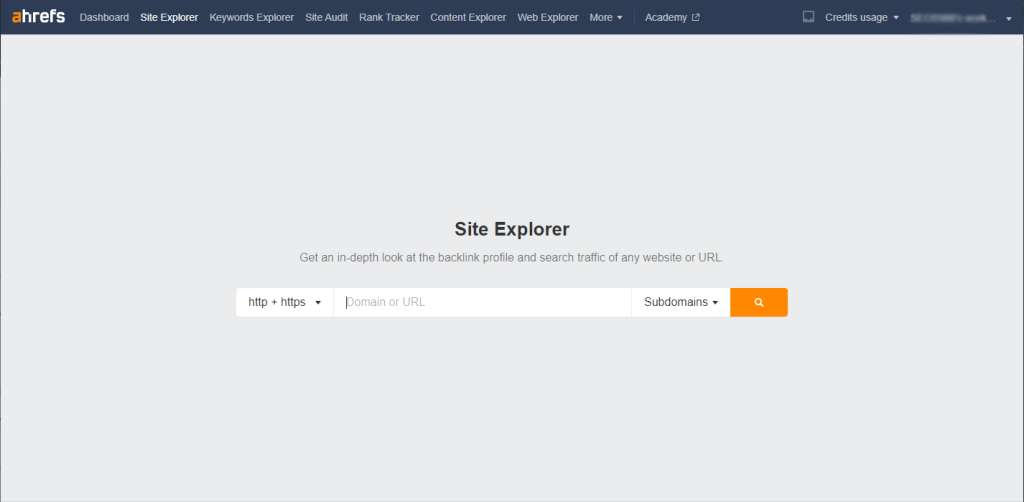
2. Input your website URL and subsequently access the “Competing Domains” segment to select pertinent competitors.
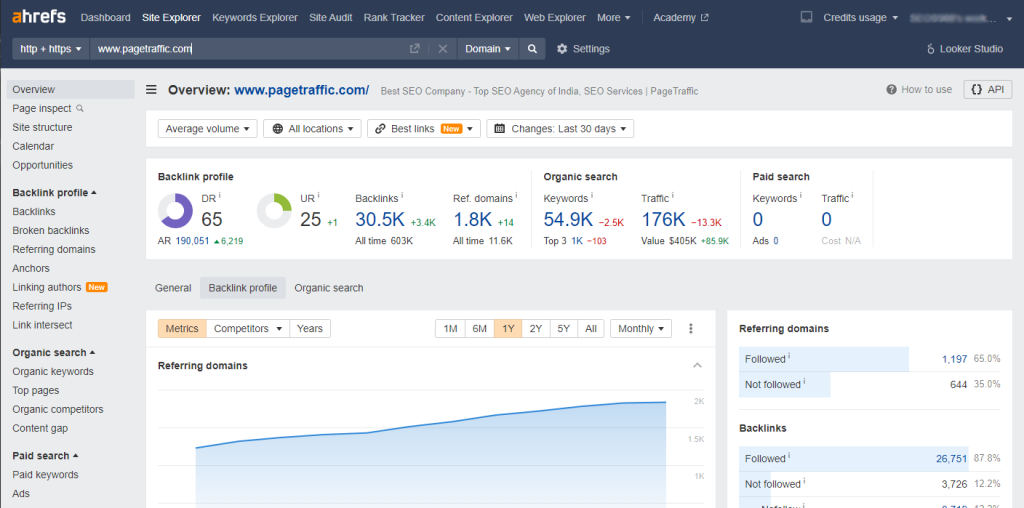
3. Launch the “Content Gap” feature.
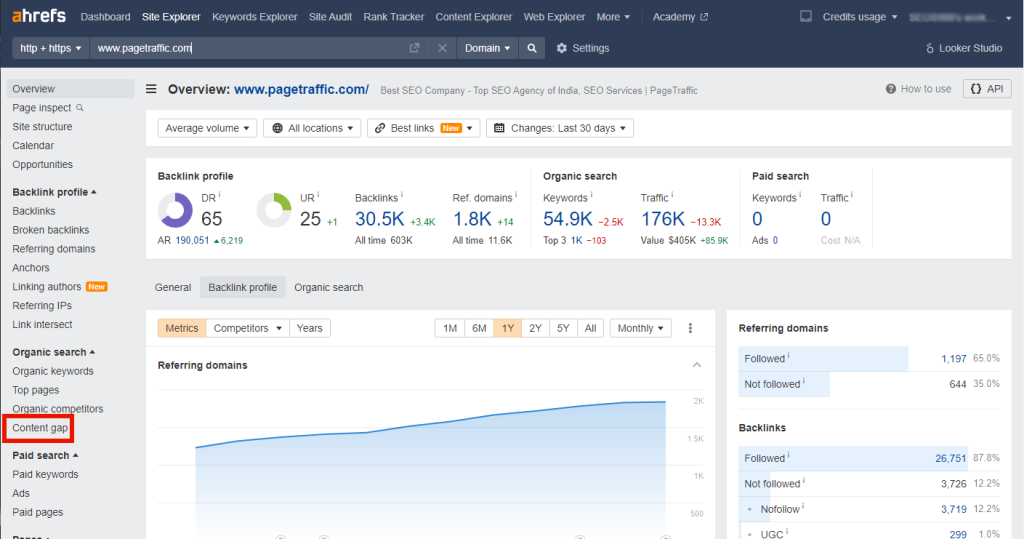
4. Within the tool, input your domain alongside your competitors’ domains.
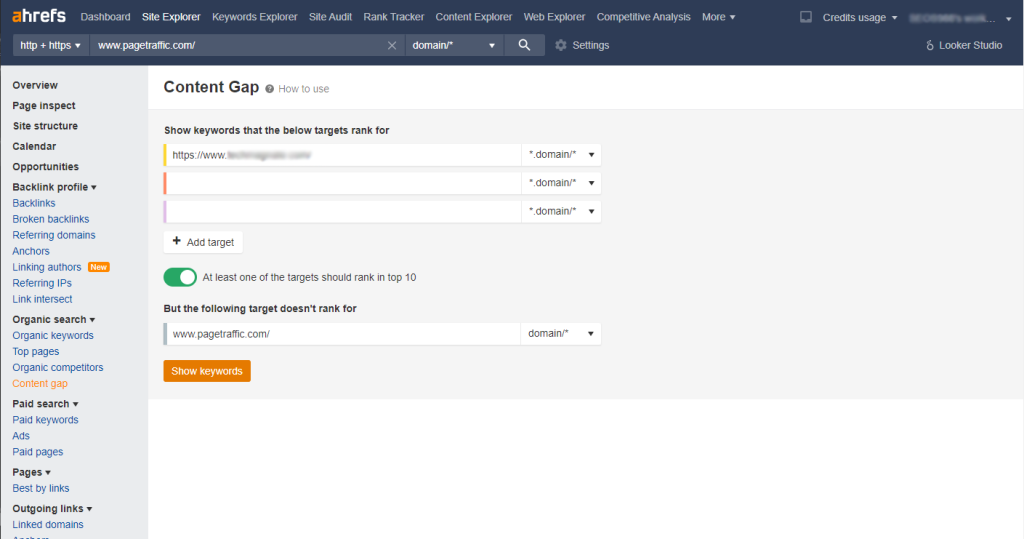
5. The output comprises keywords your competitors rank for, but you presently do not.
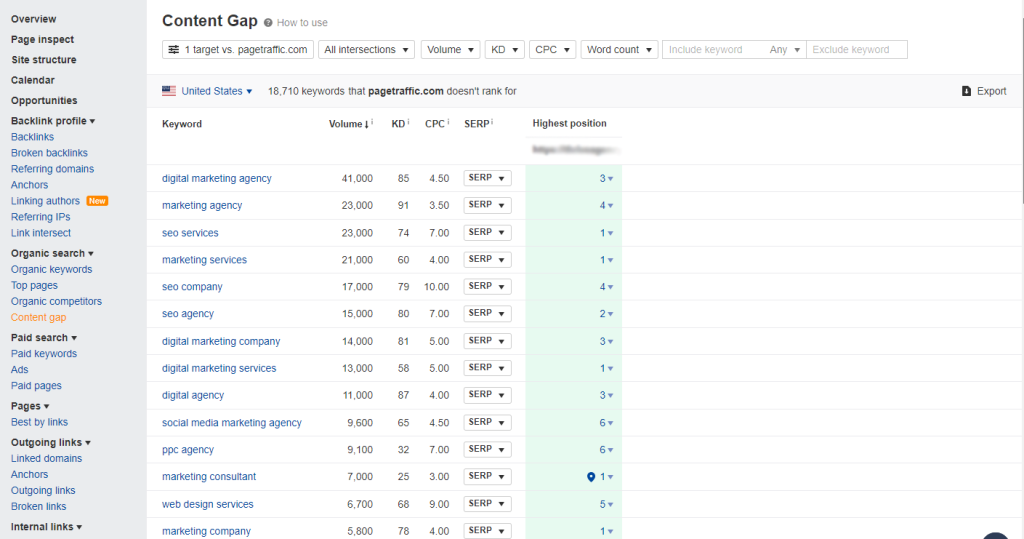
Advantages of Using Ahrefs for Content Gap Analysis
Rich Data Repository: Ahrefs boasts an expansive dataset of keywords and backlinks, ensuring users have timely and accurate insights.
User-Friendly Design: With its intuitive interface, Ahrefs demystifies content gap analysis, making it accessible even for those relatively new to SEO.
Competitive Insight: Gleaning insights from competitors’ strategies can inform and refine your own approach.
Keyword Exploration: The platform’s keyword research functionalities empower users to unearth new keyword opportunities, assess their viability, and recalibrate content strategies accordingly.
Also Read: Ahrefs Vs Semrush: Which SEO Tool Is Better And Why?
SEMrush
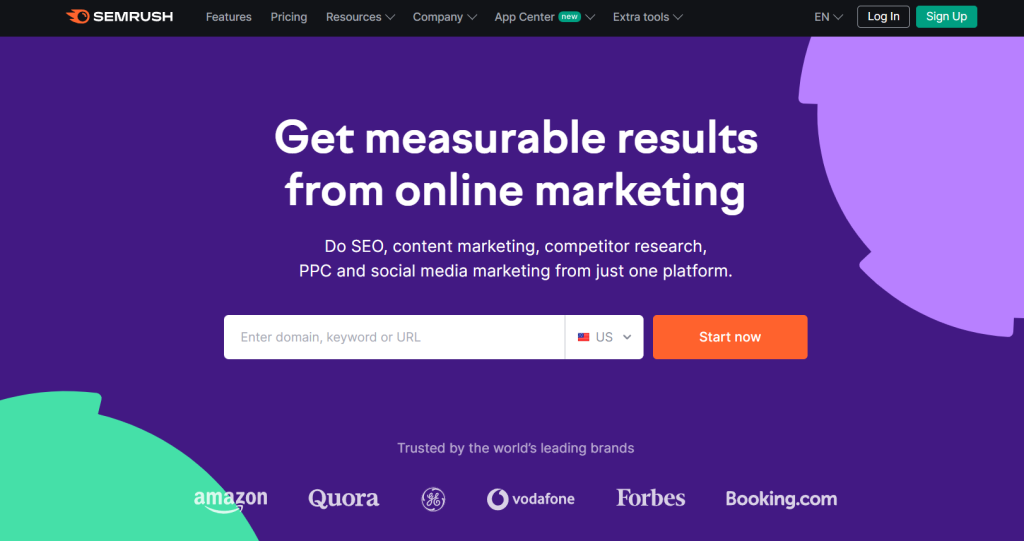
SEMrush stands out as a powerful ally for content gap analysis. Recognized as a comprehensive platform for SEO and content marketing, it facilitates keyword identification, competitive analysis, and website audits. The plethora of insights and suggestions on offer make SEMrush indispensable for uncovering content discrepancies.
SEMrush provides a suite of features that allow for continuous monitoring of your website’s performance. It serves as a consolidated platform for tracking keyword rankings, gauging website positioning, and evaluating the impact of your content initiatives.
A distinguishing attribute of SEMrush is its ability to spotlight areas of enhancement and expansion by juxtaposing a website’s strategies against its competitors. The platform’s “Gap Analysis” tool stands as its hallmark. This feature permits a granular comparison of your content landscape with that of your competitors. Here’s how to harness its capabilities:
1. After logging into SEMrush, input your domain.
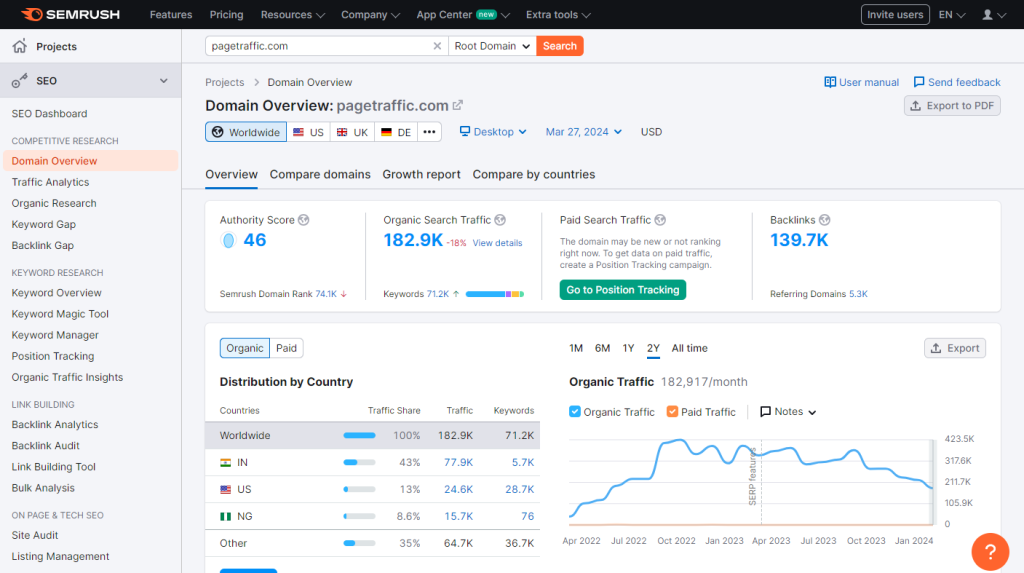
2. Navigate to the “Gap Analysis” feature.
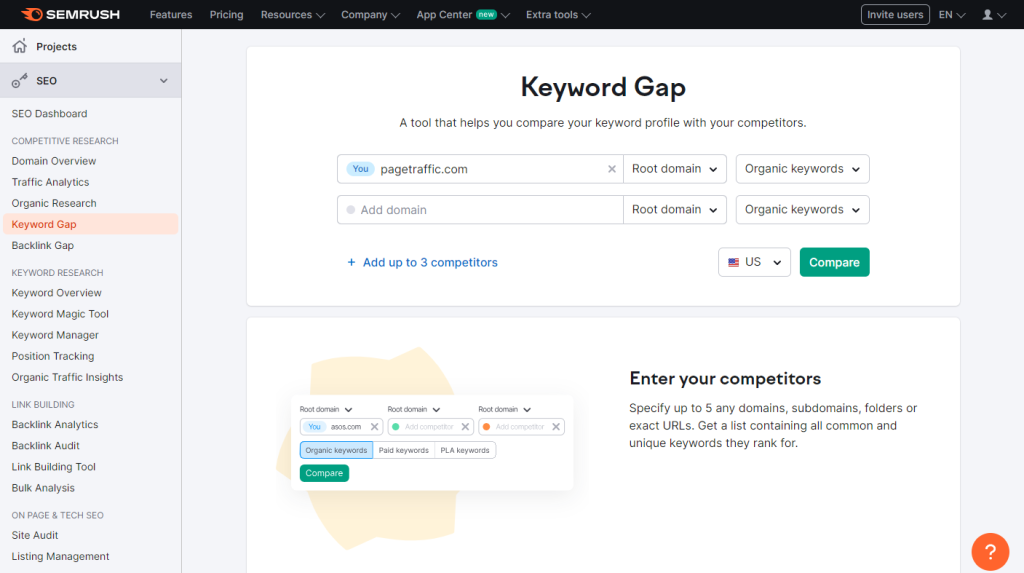
3. Enter the URLs of your competitors.
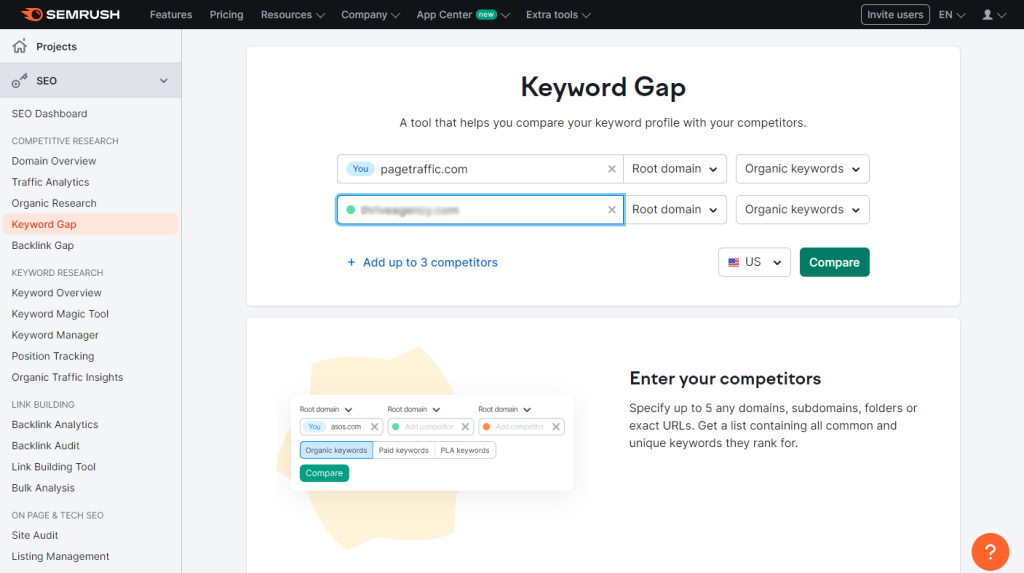
4. SEMrush will subsequently generate a comprehensive list of keywords that your competitors rank for, but which remain untapped on your end.
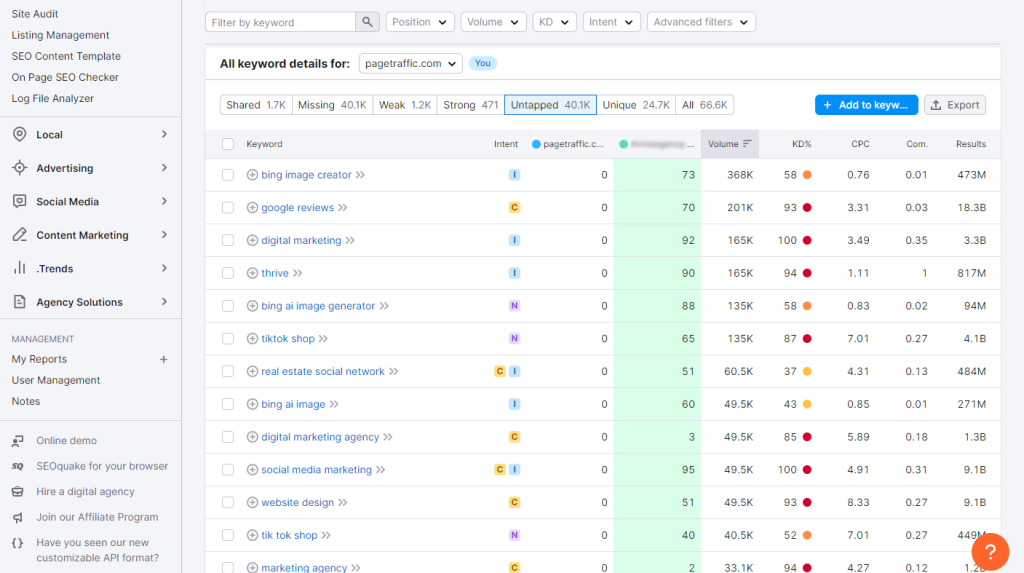
Advantages of Using SEMrush for Content Gap Analysis
Granular Competitor Analysis: SEMrush enables the identification of keywords leveraged by competitors but overlooked by you. This affords a more thorough competitive analysis and facilitates strategic content realignment.
Ingenious Content Suggestions: SEMrush aids in brainstorming content themes, ranking them by significance, thus streamlining the content creation process in alignment with strategic objectives.
All-Encompassing Platform: SEMrush amalgamates a gamut of essential tools for SEO and content marketing, ensuring you’re equipped for the entire content lifecycle, from ideation to optimization.
Case Studies: Successful Content Gap Analysis in Action
Real-World Examples of Websites Benefiting From Content Gap Analysis
Content gap analysis is a potent tool, offering tangible enhancements in a website’s search engine placement. By identifying and subsequently bridging the content voids that exist on their platform, websites can enhance their visibility and thus draw a broader audience. Let’s delve into real-life success stories of entities that harnessed content gap analysis to escalate their search engine positioning.
The Healthy Chef
- Before Content Gap Analysis:
The Healthy Chef, a portal dedicated to holistic well-being and nutritious culinary endeavors, boasted a robust readership. However, they hit a plateau in terms of visitor traffic. They noted rivals outpacing them and embarked on a content gap analysis journey to decipher the cause of their stagnated search engine performance.
- After Content Gap Analysis:
The aftermath of their comprehensive content audit was impressive. The Healthy Chef witnessed a substantial uptick in organic traffic within a short span. Their culinary video content, especially on platforms like YouTube, started gaining traction, captivating a fresh cohort of culinary enthusiasts. This bolstered the website’s credibility, propelling it to higher echelons in search results.
From being ensconced mid-way in search outcomes, they catapulted to the coveted first page for numerous search queries. This surge in visibility translated to increased web traffic, establishing them as a revered name in the health and gastronomy arena.
Healthline
- Before Content Gap Analysis:
Healthline, a revered hub for health insights and guidance, recognized the imperative of delivering meticulous, up-to-date information to its discerning readers. While their repository of health articles was expansive, they aspired to ensure its alignment with the latest medical advancements.
- After Content Gap Analysis:
Upon meticulous content scrutiny, Healthline identified areas lacking contemporary health insights, especially in relation to emergent health phenomena and conditions. They embarked on a revamp, enriching existing articles with contemporary medical findings and expert opinions. This endeavor didn’t just augment content authenticity and credibility but also provided a fillip to their search engine standings. Consequently, Healthline’s digital footprint expanded, ranking prominently for a myriad of health-centric terms, thereby attracting a larger audience in search of reliable health counsel.
The Balance
- Before Content Gap Analysis:
The Balance, a financial advisory platform, aims to assist individuals in managing their finances. However, they realized that their content lacked in-depth information on certain financial topics and emerging trends.
- After Content Gap Analysis:
Through a meticulous analysis, The Balance identified several untapped financial subjects, including cryptocurrency, investment strategies, and retirement planning. In response, they enriched their content portfolio with comprehensive articles, guides, and tutorials addressing these areas. This strategic inclusion bolstered their search engine rankings for various finance-centric keywords and spurred organic traffic from individuals seeking specialized financial counsel.
HubSpot
- Before Content Gap Analysis:
HubSpot, a renowned platform offering marketing and sales software solutions, faced stiff competition in the bustling digital marketing domain. They recognized that standing out and continually drawing a diverse user base necessitated the delivery of niche, value-driven content. They identified gaps in their offerings, particularly when it came to detailed insights into specialized industry segments and user challenges.
- After Content Gap Analysis:
HubSpot embarked on a content gap analysis to pinpoint specific industry sectors and customer segments that their content portfolio inadequately addressed. They recalibrated their content strategy to bridge these gaps, crafting detailed industry-specific guides, templates, and case studies. This nuanced approach ensured HubSpot’s content resonated more with its target audience. The outcome? Enhanced search engine visibility for industry-specific queries and an influx of organic traffic from industry-relevant sources.
Challenges in Content Gap Analysis and How to Overcome Them
Dealing With Massive Amount of Data
Content gap analysis involves sifting through vast amounts of data, such as keyword lists, competitor content, and website user behavior. Proper data management is essential. Leveraging advanced tools and software can streamline this process. Prioritizing and segmenting data ensures that efforts are channeled towards critical content deficiencies. Periodically updating and organizing data ensures that insights derived remain relevant and actionable.
Ensuring Content Remains Genuine and Not Just for the Sake of Filling Gaps
While addressing content gaps is critical, the emphasis should be on producing meaningful and high-quality content, rather than merely generating volume. It’s crucial to create content that genuinely offers value to users instead of producing content just to fill identified gaps. Over-reliance on keywords or churning out low-quality content can tarnish a website’s reputation and adversely impact its search engine standings.
A successful content gap analysis should lead to the development of content that resonates with users’ genuine needs and showcases the brand’s expertise in its domain. Striking the right balance between the volume of content and its quality is pivotal for sustained success.
Staying Updated With Industry Changes and Trends
The digital landscape is in perpetual flux, with industries evolving and consumer preferences continually transforming. For effective content strategies, it’s imperative to stay updated with emerging trends, algorithmic tweaks, and shifts in user behavior.
Maintaining this alertness ensures that content remains aligned with the latest industry developments and resonates with current user preferences. To stay ahead in the competitive online realm, keeping pace with evolving search engine guidelines and burgeoning trends is indispensable, ensuring consistent organic traffic and delivering relevant, up-to-date information to the audience.
Conclusion
Content gap analysis is invaluable not just for large corporations but also for enterprises of all sizes. This process assists companies in refining their content strategies, amplifying their online presence, and fostering deeper connections with their target audience. By identifying and addressing content deficiencies, even small to medium-sized businesses can stand toe-to-toe with industry giants, attract organic website traffic, and position themselves as authoritative voices in their domain.
Achieving digital success is not a one-time feat. It demands businesses to be adaptive, making regular alterations and enhancements to their strategies. Periodic content assessments and gap analyses aren’t mere tick-box exercises; they are continuous endeavors demanding persistent commitment.
Undertaking these periodic assessments enables businesses to discern the evolving needs and preferences of their audience, ensuring they remain a step ahead of the competition. Emphasizing the significance of these practices motivates readers to stay proactive, maintain online relevancy, and consolidate their stance as industry frontrunners. This proactive approach isn’t just a wise decision; it’s an essential investment for thriving in the dynamic digital marketing landscape.
FAQs
Can e-commerce ventures benefit from content gap analysis?
Absolutely. Content gap analysis is pivotal for e-commerce platforms. It aids in identifying deficiencies in product information, enhancing product descriptions, and unearthing avenues to augment online visibility. It can elevate product search rankings and draw more visitors.
Is content gap analysis pertinent only to written content?
No, content gap analysis transcends written content. It’s applicable to diverse content forms, including images and videos. This practice can identify gaps across various media types, catering to diverse audience inclinations and elevating overall content quality.
How do I prioritize content gaps?
Prioritization hinges on factors like search volume for keywords, keyword competitiveness, relevance to a target audience, and existing content saturation within the domain. High-priority gaps typically align with high-demand topics that are underrepresented.
Should content gap analysis be a one-off exercise?
No. With evolving online dynamics and shifting user preferences, regular content gap assessments are essential to remain competitive, stay abreast of current trends, and continually deliver fresh, relevant content.
